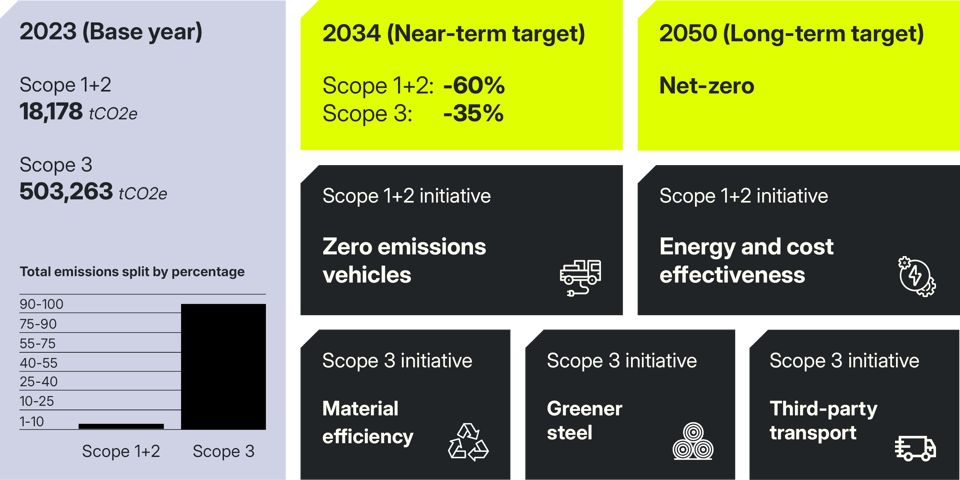
Climate
At Saferoad, we see climate action as an essential part of our sustainability efforts. We are working to reduce our emissions and contribute to a lower-carbon future. Given our connection to carbon-intensive industries, we recognise the importance of taking meaningful steps forward. By setting science-informed targets, improving energy use, and promoting circular approaches to materials, we aim to support the development of more resilient infrastructure over time.
Strategic priorities
Our climate efforts centre around two interconnected focus areas: reducing greenhouse gas emissions and applying circular economy principles to help reduce waste. These approaches are intended to strengthen the efficiency and long-term sustainability of our value chain.
|
Climate action |
|
|
Closing the material loop |
|
Read more about our progress and latest performance in our Integrated Annual Report
Our decarbonisation plan
Grounded in science. Focused on long-term value.
Saferoad Group’s climate targets have been officially validated by the Science Based Targets initiative (SBTi). This confirms that our emissions reduction plans are in line with the ambition to limit global warming to 1.5°C, as set out in the Paris Agreement. The targets apply across our operations and selected parts of our value chain, and reflect our ongoing work to reduce our environmental impact and contribute to more sustainable infrastructure solutions.
“Having our targets validated by the SBTi gives credibility to our climate ambitions. It confirms that we are not only aligned, but on a verified path to reduce emissions across our operations and supply chain. Sustainability and safety are linked, and this milestone strengthens our role in supporting a safe and climate-resilient infrastructure for the future,” says Bernd Frühwald, CEO of Saferoad Group.

Delivering emissions cuts by 2034
We have set near-term science-based targets to reduce greenhouse gas emissions from a 2023 base year. These targets include:
- A 60% reduction in Scope 1 and 2 emissions.
- A 35% reduction in Scope 3 emissions from purchased goods and services, and upstream transportation and distribution.
- A goal that 25% of suppliers by spend covering purchased goods and services and upstream transportation and distribution will have science-based targets in place by 2029.
These targets are aligned with the SBTi’s Net-Zero Standard and represent a structured approach to decarbonisation in areas we can influence directly and indirectly.
Decarbonising with five main levers
To achieve the ambitious 2034 targets, we will work to pursue five key levers:
- Zero-emission vehicles: transitioning to a fleet of zero emission vehicles to minimise direct emissions
- Energy and cost efficiency: implementing energy efficient practices and cost-saving measures across all operations
- Material efficiency: optimizing production and product design, and light-weighting products to reduce the need for materials
- Greener steel: sourcing and utilising greener steel to reduce the carbon footprint of our materials
- Decarbonised third-party transportation: collaborating with third-party transportation providers to ensure their operations are aligned with our decarbonisation goals
We are currently developing and refining the pathways needed to reach these goals. This includes business area-specific initiatives, annual reviews of progress, and integration into our wider business and investment planning. Our transition plan is designed to be flexible and will be updated as conditions, technologies, and regulatory frameworks evolve.
Reaching Net-Zero by 2050
In line with the SBTi Net-Zero Standard, Saferoad aims to achieve a 90% absolute reduction in Scope 1, 2 and 3 emissions by 2050. Any remaining emissions at that point are expected to be neutralised in accordance with established criteria.
Working together for systemic impact
Saferoad recognises that decarbonisation depends not only on internal efforts but also on systemic change. Our success will rely on four key enablers:
- Alignment of decarbonisation and investment strategies
- Growing market demand for low-carbon solutions
- Wider availability of clean technologies (e.g. hydrogen, fossil-free trucks)
- Increased share of renewable energy in the electricity grid in Central and Eastern Europe
We call on our partners, suppliers and authorities to collaborate in creating the regulatory conditions needed for a successful transition.
We remain vigilant of the investment and operational changes necessary to reach our targets, as well as the regulatory developments essential for a successful transition. While we work to understand the short-term financial impacts of the transition plan, we acknowledge that significant market uncertainty and volatility present challenges in estimating long-term effects. We plan to conduct a climate risk assessment aligned with upcoming reporting deadlines. For more information, please contact us.